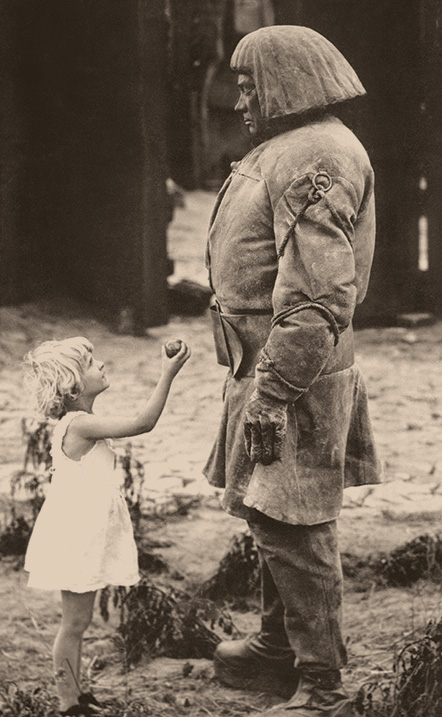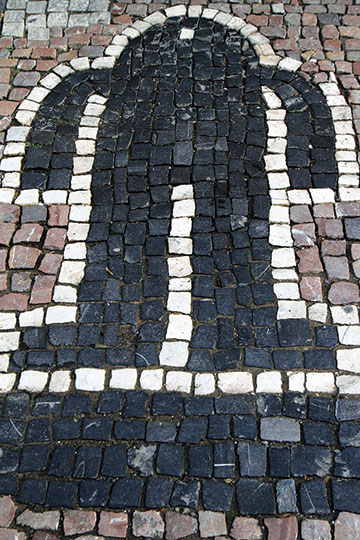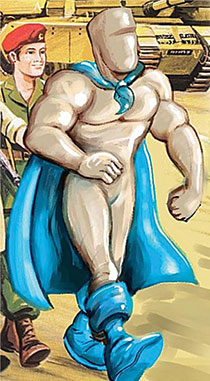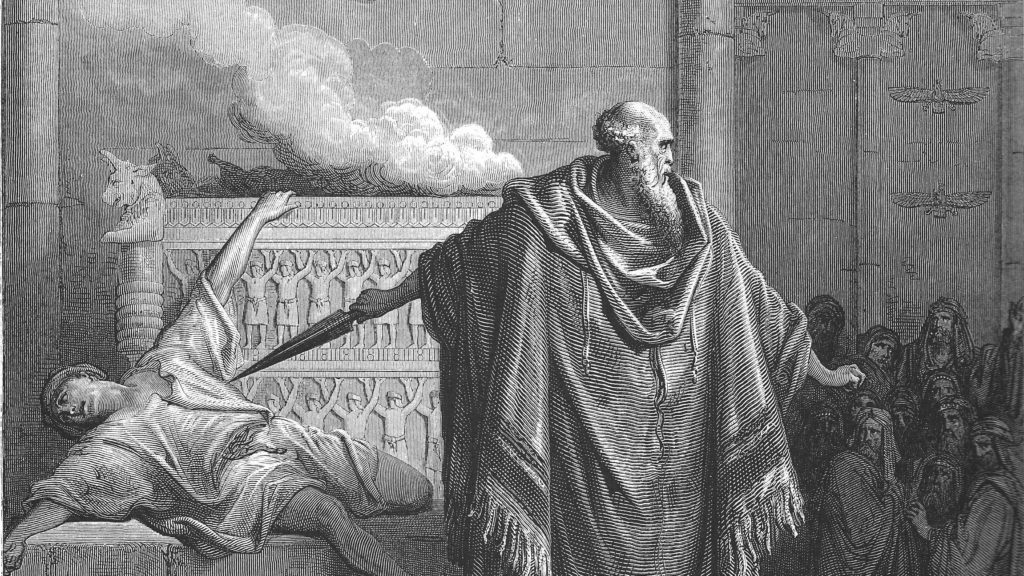Brave New Golems
There is a good chance that a golem is lurking near you at this very moment. You won’t see it, though, unless you’re viewing your surroundings through your smartphone’s Pokémon GO app. As over 100 million players know, the game challenges one to capture virtual creatures stationed in physical locations across the globe. True, the Pokémon golem looks more like a dinosaur than the foreboding, helmet-headed colossus that has dominated visual portrayals of the golem since Paul Wegener’s famous silent film of 1920. But that’s the way of golems these days. As pop culture monsters they don’t have the cachet of zombies or vampires, but they are all over the place: in film and television, video games and comic books, and a continuous stream of novels both highbrow and popular. And while in most cases these golems are explicitly connected with Jews, in some of the recent incarnations the relation to the golem legend, or to anything Jewish at all, is, at best, tenuous.
Of course, what we usually think of as the golem legend in its classical form—a magically created humanoid who does the bidding of a kabbalist—does not have especially deep roots in Jewish tradition. The word itself occurs only once in the Bible, and refers to the unformed state of the human being before being shaped into life by God:
My frame was not hidden from Thee, when I was made in secret, and curiously wrought in the lowest parts of the earth. Thine eyes did see mine unformed substance [golmi], and in Thy book they were all written. (Psalms 139:15–16)
In the Talmud we first encounter the idea that magical or divine energies can be used to create artificial life. “Rava created a man,” we read, “and sent him to Rabbi Zera” (Sanh. 65b) who returns the unspeaking automaton to dust, but it’s a one-off story and hardly a focus of interest in later rabbinic literature. Among the Jews of medieval France and Germany there are references to the magical creation of artificial beings, but, according to Gershom Scholem, even in this period the creation of a golem was primarily a mystical exercise that, significantly, did not involve making an animate servant. Rather, in forming a human shape from clay the ritual allowed the mystic to enter into ecstatic contemplation of God’s creative powers. According to Scholem, “the golem, no sooner created, is dissolved again into dust: with the initiation of the Talmudist it has served its purpose, which is purely psychic.”
The familiar version of the golem story takes place in Prague, where the creature is brought to life by the Maharal, the 16th-century rabbi Judah Loew, in order to protect the Jewish community from Christian violence. In some versions of the tale, the Maharal animates the golem by placing a scroll in its mouth; in others, he inscribes Hebrew letters on the golem’s forehead. Having either served its purpose or gotten out of control, the golem is later deactivated by removing the parchment from its mouth or by erasing one of the letters on its brow, turning the word emet (truth) into met (dead). And yet this story does not take shape before the 17th century, well after the death of the Maharal who, in historical fact, never claimed to have created a golem despite these latter-day legends and the current enthusiasm of the Czech tourist industry.

Indeed, the modern popularity of the story owes far more to non-Jewish writers in the 19th and early 20th centuries than to any Jewish preoccupation with golems. Important milestones are the 1808 publication by Jacob Grimm of a golem legend as part of his researches into European folklore; the Austrian writer Gustav Meyrink’s best-selling novel of a sinister and otherworldly Prague, first published in serial form beginning in 1913; and Wegener’s captivating film, which was actually one of three golem movies he produced between 1914 and 1920, the first sci-fi trilogy in cinematic history (though the first two films were lost).
The most popular rendition of the golem story by any Jewish creator during this period was a collection of tales first published in Hebrew in 1909 by the Polish rabbi Yudl Rosenberg, who claimed that his book was based on a rare early-17th-century manuscript in his possession. In fact, there was no such manuscript and The Wondrous Deeds of the Maharal of Prague was largely Rosenberg’s own invention, a cycle of adventure stories in which Rabbi Loew and his sidekick, the golem Yossele, repeatedly defeat the nefarious schemes of the anti-Semitic priest Thaddeus to frame the Jewish community of Prague with blood libel accusations. And so, while the golem is taken as a metaphor for Jewish authenticity and folk tradition itself, its actual history is rather modern and Christian.
To these observations, I would add a further, perhaps controversial point. As monsters go, golems are pretty boring. Mute, crudely fashioned household servants and protectors, in essence they’re not much different from the brooms in the “Sorcerer’s Apprentice” story best known today from Walt Disney’s Fantasia. Appropriately, in Yiddish the word means a blockhead or dunce. Since the beginning of the 20th century, there have been attempts to see in the golem story an image of technology run amok: a precursor to robots, computers, weapons of mass destruction, clones, and genetic engineering. Yet these metaphorical connections, while suggestive, leave the simple clay of the golem story itself far behind. Similarly, it is sometimes imagined that Mary Shelley’s Frankenstein was inspired by the golem story, but the juxtaposition is itself telling: Shelley’s monster became an icon of romanticism because of its rending self-consciousness, its loneliness and eloquence—in short, everything that the golem typically lacks. It is not surprising that the most famous golem novel, Meyrink’s The Golem, and the most brilliant modern literary work to feature the golem, H. Leyvik’s Yiddish play of the same title, each tend to ignore the classic golem story and focus on other themes.
We have, then, a bit of a puzzle. Golems are dull and Judaically marginal. Yet they continue to proliferate in popular culture and, moreover, are taken to be the quintessence of Jewish fantasy. Why?
One reason for the attraction of the golem is that it has served as a charged metaphor for Jews and Judaism themselves, reflecting the biases of Christian writers who first took this obscure story and popularized it in the course of the 1800s, as well as attempts by later artists, Jewish and Christian alike, to reframe the figure in more positive terms.
Golems, after all, are ugly, crude, lumbering clods of earth. They are of limited utility, cannot think for themselves or can do so only in the most literal-minded fashion, and must not be allowed to get out of hand. They are, in short, a classically negative Christian imagining of Judaism itself: unlovely, slightly threatening, and hopelessly literal and earthbound. The golem is a perfectly Pauline figure for Judaism as crude and unimaginative materialism, the dominance of the letter (in this case, the Hebrew letters famously inscribed on the golem’s brow) over the spirit.
Further, as Cathy Gelbin notes in her 2010 study The Golem Returns: From German Romantic Literature to Global Jewish Culture, 1808–2008, the 19th-century emergence of the golem story in European literature resonated with questions that were being asked about Jews at the time, in particular how fully human (and thus worthy of citizenship) they were. Or, in the context of romantic nationalism, whether Jews were capable of true artistic creation, or whether, like makers of golems, they could produce only weak, soulless artifacts. Jewish writers responded in turn by presenting the golem legend as proof of Jewish national creativity and the possession of a popular folk culture.
This is not to suggest that Pokémon GO is a meditation on the Jewish Question, but the golem still crops up in interesting, sometimes unsettling ways. Take, for instance, the 2004 novel Iron Council by the celebrated British author China Miéville. Miéville, thought by many to be one of the most significant fantasy writers working today, is a socialist, and Iron Council is a meditation on the dream of violent revolution, rendered in a steampunk sci-fi idiom. Interestingly, the main character and leader of the revolution is a golem-maker named Judah Low—though this one inhabits the labyrinthine megalopolis New Crobuzon rather than Prague.
In fact, Iron Council seems to be awash in Jews—the novel’s revolutionaries refer to each other as “chaver,” Low’s main disciple is named Uri, and the novel’s villain is named Jacobs. Yet Miéville himself is an outspoken anti-Israel propagandist. The novel may therefore tell us something not only about revolutionary politics as Miéville sees it, but about the place of Jews in the progressive imagination today, especially in the context of the ongoing metastasization of anti-Semitism and anti-Zionism within the British Left. Miéville’s Judah Low is the last, best hope of the revolutionaries, yet at the end of the novel he betrays the revolution. Fearing that his comrades on the barricades will be massacred by the bosses and their militia, Low “saves” them by enveloping them in a “time golem,” to be forever frozen a split second before the present. Low protests that he was only trying to rescue those he loves, but his outraged comrades indict him:
[W]e were never yours, Judah. We were something real, and we came in our time, and we made our decision, and it was not yours. Whether we were right or wrong, it was our history. You were never our augur, Judah. Never our saviour.
Thus radical fantasy in the 21st century returns us to the tropes of Jew as savior and Jew as traitor, Christ and Judas; the modern golem reminds us of its origins in European unease regarding Jews (“it was our history”).
A second factor in the popularity of the golem is its use as a figure for meditations on Jewish power, violence, and vengeance. The theme of the golem as a household servant that malfunctions dates from the 17th century, and by the end of the 19th century the golem becomes the protector of the Jews against Christian violence, a protector that sometimes grows so indiscriminately violent that it must be destroyed by those whom it protects. In 1893 I. L. Peretz penned a brilliantly satirical version of the golem story in which the golem successfully defends the Jews of Prague from being massacred by their Christian neighbors. Peretz’s Jews then plead with their rabbi to deactivate the golem since if it continues its rampage “there won’t be any Gentiles left to heat the Sabbath ovens or to take down the Sabbath lamps.” Committed to the status quo of diasporic powerlessness, the Jews allow the golem to be locked away in the synagogue attic under cobwebs—a symbol for dormant Jewish vitality.
By contrast, in a number of 20th-century American iterations the golem is a figure for what Peretz in his own time was satirizing: Jewish discomfort with violence. From Marvel comics to Michael Chabon’s novel The Amazing Adventures of Kavalier and Clay, the golem becomes a figure for Jewish vengeance against Nazis, about which the stories express deep ambivalence. On the other hand, the non-Jewish film director Quentin Tarantino cheerfully embraces the golem without any ambivalence whatsoever. In his film Inglourious Basterds, an unapologetic fantasy of revenge by Jews on Nazis, an exasperated Hitler whines to his generals about the Jewish American GI, played by Eli Roth, who likes to brain Nazi soldiers with a Louisville Slugger:
How much more of these Jew swine must I endure? They butcher my men like they were flies! . . . Do you know the latest rumor they’ve conjured up, in their fear-induced delirium? The one that beats my boys with a bat. The one they call “the Bear Jew” . . . is a golem.
As long as Jews fantasize and worry about power, and as long as non-Jews ponder the relationship between Jews and violence, it seems the golem will continue to be revived.
In her wide-ranging new monograph, Golem: Modern Wars and Their Monsters, Maya Barzilai argues that the myth of the golem tells us something about humanity more generally. It teaches us about what she calls “the golem condition,” in which “the fantasies of expanding our capacities and transgressing our natural boundaries are always curbed by the inborn limitations of human existence.” In five chapters she discusses, respectively, Wegener’s golem films, their reception in the United States, the changing use of the golem motif in Israeli writing in the 1940s and 50s, the golem as an ambivalent figure for post-Holocaust Jewish revenge in American popular culture, and the intersection of the golem with writing about cyborgs and artificial intelligence. Barzilai sees the golem as a metaphor for the evils of war, militarism, and destructive technology.
Barzilai’s interpretation of Marge Piercy’s 1991 golem novel He, She and It in this context is illuminating, as is her discussion of the golem motifs in S. Y. Agnon’s novel To This Day, which treats the relationships between Jews and Christians in Berlin. In other cases, her emphasis on war and technology is less convincing, as when she argues that the golem’s clay in Wegener’s film is akin to the mud of the trenches in World War I. Indeed, there is a tension running through this study between Barzilai’s desire to analyze a figure that has become so deeply embedded in modern Jewish culture, on the one hand, and on the other a subtly polemical impulse to reframe the golem in terms that seem to her more usefully subversive. She is, she writes, “concerned with the living-dead golem as a transgressive monster that enabled artists to call into question national narratives, as opposed to nostalgically portraying a Jewish minority and its desire for protection,” and so the texts she chooses to treat—and the theoretical authorities, including Antonio Negri and Michael Hardt, to whom she nods—often reflect that interest.
Yet neither the questioning of national narratives nor the dread of militarism and technology really work as an explanation for the ongoing popularity of the golem. The fact is that, more than ever, the golem is today the archetypal point of connection between Judaism and popular culture itself, a way for Jewishness to be introduced into the worlds of fantasy and other genre fiction. In this sense, the golem is popular because it represents a Jewishness that is global, virtual, and entertaining.

It is no accident, for instance, that golems feature centrally in Emily Barton’s recent attempt to fashion a Jewish fantasy novel. The Book of Esther, Barton’s third book and first attempt at fantasy, conjures an alternate-history 1942 in which the Nazi war in Europe comes to the borders of Khazaria, the fabled medieval Jewish kingdom that still exists in the 20th century of Barton’s imagination. (For an overview of the actual Khazar kingdom and the way it has been recently dragooned into pseudoscientific theories about Jewish origins, see Shaul Stampfer’s “Are We All Khazars Now?” in our Spring 2014 issue.) The book’s eponymous heroine is the teenaged daughter of Khazaria’s vizier. Seeing the danger posed to her country by the Germans, yet prohibited because of her sex from taking a role in battle, Esther sets out to find a village of kabbalists who will transform her into a man. The plan doesn’t go entirely as expected, but she does learn how to make an army of golems, and she collects, in Wizard of Oz fashion, an eclectic range of companions (gender-bending kabbalists, Karaites, Uyghurs, Yiddish-speaking Ostjuden, etc.) to add to her valiant troop.
Barton’s golems, it turns out, are not the docile servants of legend, but their rebellion takes an unexpected form: They want to be accepted as Jews and pray side-by-side with their masters. Though the question of whether a golem can count in a minyan is actually a classic halakhic dispute, the more traditionally minded members of Esther’s company are scandalized by the very thought: “it goes against nature,” says one. Nevertheless, the golems’ petition triggers more familiar questions: Why shouldn’t women be allowed to count in a minyan? Why aren’t Karaites accepted as fellow Jews? Can’t the non-Jewish Uyghurs participate in prayers? Esther comes to a realization: “I can’t imagine it pleases Hashem if some who desire to worship Him are forbidden to.” In short, Barton’s novel is a liberal Jewish allegory about perceived inequalities within traditional Judaism. Her golems are less constructed than Reconstructed.
The real enemy in The Book of Esther, one soon grasps, is not the Nazis, but the traditionalists who rule Khazaria. One can’t help but compare Barton’s Jewish kingdom with the one in Michael Chabon’s adventure tale Gentlemen of the Road, a book which also features a cross-dressing Khazarian heroine and characters trying to repel an invasion. Surprisingly, Chabon’s 12th-century Khazaria is a far more cosmopolitan and freewheeling place than Barton’s insular, stiflingly traditionalist 20th-century realm. Barton’s characters therefore spend far more time arguing about egalitarianism and gender status than the safety of their homeland. As Esther, in the face of the immanent Holocaust, mentally prioritizes: “So she was alone, her mind wheeling through the possibilities of foreign domination, enslavement, mass murder, and above all else, who she would be if she became a man.”
The novel’s contemporary priorities and Jewish polemics aside, how does The Book of Esther stand up as fantasy? Unfortunately, not very well. There are weaknesses in plotting and characterization, but most fatal is Barton’s failure to create either a believable alternate reality or a compellingly strange fantasyland. The novel undercuts its attempts to introduce a sense of the marvelous by having the characters accept some wonders as perfectly ordinary and others as cause for amazement. Golems are presented as extraordinary, yet the Khazarians ride far more impressive mechanical horses without much comment. More problematically, the Judaism of this Jewish fantasyland is not woven into the fabric of the novel’s reality, but instead belabored as a problem for the characters, who constantly explain and question basic Jewish practices to themselves and each other. Not a page goes by without some character asking which blessing to make over a type of food, or delivering a mental exposition on the significance of mikvah or eruv, and the result feels more like a conversion class than a fantasy novel.
Sabbath rules are especially perplexing to Esther and her army, who argue over halakhic questions (whether one can march and fight on Shabbat) that were resolved in the time of the Maccabees. At points this verges on self-parody, as when Esther takes her concern to remain modest to unprecedented lengths as she fights a group of German soldiers: “A man grabbed hold of her foot and she kicked him before thinking to fire the pistol. So much for the injunction not to touch a man outside one’s family.” Had Barton trusted her Jewish materials to speak for themselves without trailing explanatory apparatus the result might have been more magical.

If Barton’s fantasy world feels disappointingly familiar, The Golem of Hollywood and The Golem of Paris, two paperback potboilers written by the father-and-son team of Jonathan and Jesse Kellerman, introduce supernatural elements into our own world with results that are, at least, successfully weird. That last adjective may sound vague, but how else does one describe a pair of thrillers in which the Los Angeles Police Department has a special unit staffed by the descendants of the biblical nephilim (the gigantic offspring of “the sons of God”—traditionally understood to be angels—and “the daughters of men,” see Genesis 6)? These giants are charged with the apprehension of the golem, who is actually the reincarnated spirit of Cain and Abel’s sister and now takes the form of a giant flying beetle that hunts serial killers on both sides of the Atlantic.
Female golems like the Kellermans’ don’t often get their due, though there is a long enough tradition of them, running back through Cynthia Ozick’s Xanthippe to author-politician Walther Rathenau’s fin de siècle story about a golem-wife to 19th-century
romantic antecedents. This one acts as the protector—and a sexually jealous one—of the Kellermans’ protagonist, a hard-drinking police detective named Jacob Lev, a Robert Ludlum character lost in a Kafkaesque universe. The first novel introduces Lev, his mysterious bond with the golem, and his conflicted relationship with his parents. It also gives us a wildly original backstory for this female golem through an apocryphal book of the Bible treating the secret history of Cain and his doomed love for his sister.
Book two fills in the backstory of Lev’s mother. In contrast to the uncertain use of Judaism in The Book of Esther, the Kellermans place its discovery by Lev’s mother front and center, portrayed with moving authenticity, as when the non-observant Jewish teenager attends her first Shabbat dinner:
The singing began—noisy, joyously out of sync. People swayed, people stood still. There seemed to be no rules, yet Barbara felt she was breaking one simply by existing. A little white booklet appeared in front of her. She stared at Hebrew, blocks and blocks of incomprehensible Hebrew. For all she knew, she was holding it upside-down.
Later, Barbara—now named Bina—is imprisoned and tortured behind the Iron Curtain, which shatters her sanity (and makes for extremely gruesome reading). Throughout, the Kellermans lay on the literary references from the Bible to moderns like Kafka (that beetle) and Bulgakov, numerical and name play (clocks, for instance, tend to display Jewishly symbolic numbers like 6:13), and the occasional odd bit of Kabbalah.
The sum of these unlikely parts doesn’t always make sense—many long-time readers of the Kellermans were understandably baffled—yet is compelling nonetheless and not least because the thriller genre actually fits the Kellermans’ understanding of Judaism. Their golem is a figure for Judaism’s drama, for a tradition that is itself a kind of potboiler, pulsatingly alive if not always conventionally pious or easily consoling. To be Jewish is, for the Kellermans, to be forced to confront forces both celestial and demonic, to struggle against external and internal evil. The Kellermans’ description of one of the golem’s flights (she can turn into a beetle, remember) sums up the books and their Jewish message as a whole: “It’s the same as always: for one terrifying moment, gravity overpowers faith, and she plunges toward the earth. Then she remembers who she is, and she begins to rise.”
The golem, then, can be used in many different ways. A particularly delightful instance of this plasticity is the book Ha-golem: sipuro shel komiks yisraeli (The Golem: The Story of an Israeli Comic, 2003) by the cultural historian Eli Eshed and Uri Fink, Israel’s most successful comic artist. The book purports to be a scholarly history of Israel’s most popular superhero comic, The Golem, from its beginnings in the 1930s to the present. In fact, the comic book and its entire history are the invention of Eshed, who uses the figure to dramatize the history of Israeli popular fiction, and Fink, who forges perfectly executed “samples” of the nonexistent comic book in various styles of Israeli popular illustration from the last 80 years. The book sends up Israeli national tropes and patriotic shibboleths, with the golem joined in various panels by David Ben-Gurion, Ariel Sharon, and others. One of the things that allows the book to work so convincingly is the blank face of Fink’s golem, featureless save, usually, for a Star of David. The golem is a contentless cipher, so Eshed and Fink can stick the caped super-Israeli in any decade and render it in any style they want.
So while I would just as soon let most of the new golems remain hidden under cobwebs in the attic, some writers and artists are clearly capable of molding the dull clay of the golem tale into new forms. A surprise is always possible. Take, as a last example, a scene in the French graphic novelist Joann Sfar’s bittersweet Vampire Loves (English translation 2006). Sfar first introduced his golem in the 1990s. In Vampire Loves, the golem now belongs to a Holocaust survivor named Eliyahu whose wife and daughter were murdered. At one point Eliyahu is moved to sing Sfar’s invention of a Hasidic tune, including the lyrics:
Thank you for misfortune, which makes us all unique.
We enter the world dumb as golems.
And misfortune molds us. Thank you, Lord, who gives us all a history.
Thank you, Lord, who did not make us golems.
In suggesting that we become human inasmuch as we are shaped by the misfortunes of the world, Sfar daringly returns the golem back to its first mention in the book of Psalms. We begin as golems, before God and the sorrows of history etch their letters onto our brows. Sfar compounds the touching irony as the scene ends, when Eliyahu’s golem, who can only repeat robotically what its master says, responds with something between an affirmation and a lie. “Thank you, Lord,” says the golem, “Who did not make us golems.”
Suggested Reading
A Neoplatonic Affair
As the tapestry of Hillel Halkin's first novel unfurls, we see how perfectly each part fits into the larger pattern.

Hanukkah and State: The Hasmonean Legacy
The exchange between Rabbi Riskin and Rabbi Sacks on Jewish power and politics is illuminated by the history of Hanukkah.

Jewish Destiny in a Cheek Swab
Possible Jewish ancestry has fascinated both Jews and non-Jews when it comes to American historical figures, reaching as far back as Alexander Hamilton.
Letters, Fall 2019
Austro-Hungarian Eden?; The Diaspora Strikes Back!; In Performance There Is Problem; Tact, Truth, and Tercets; Mameloshn

Comments
You must log in to comment Log In